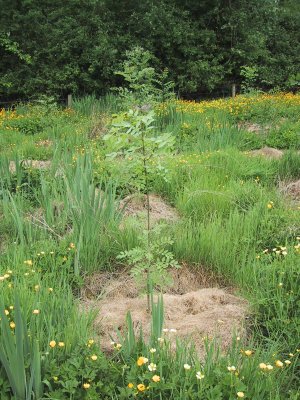Ash – growth related factors identified
This project examined the factors that encourage growth rates of broadleaves in order to improve their viability. Adequate soil fertility and weed control were identified as being essential for fast, cost effective establishment.
The research also highlighted the importance of proper site selection and good sapling quality and handling.
Implications
- Ash is a species with a relatively short rotation and has a multiplicity of end uses. It provides farmers with an opportunity to diversify their plantation without affecting future production too much. Where sites are deemed suitable it should be planted as part of the total plantation.
- Ash is a demanding species and it must be planted on the right site type. The site must be fertile, free draining, moisture retentive and sheltered.
- Plants for planting must be selected carefully. They should have a healthy, fibrous root system and have a stout root collar. On good sites the ideal plant heights are 70-90 cm.
- Chemical vegetation control is critical for reduced tree mortality and increased tree growth rates in the establishment phase. These results confirm that only a zone of between 0.5 m and 1.0 m in diameter is required.
- Spraying on sites needs to be carried out for three consecutive years following planting.
Background
The nutrient requirements, weed control and silviculture of broadleaved trees has been studied at Johnstown Castle for a number of years.

Findings
Ash requires a deep, fertile, free draining soil type. It has a high nutrient requirement and benefits from a good supply of water. It is one of the most site demanding species planted. From the trials laid down on Ash nutrient requirements, it was shown that on proper Ash sites no extra fertiliser was required for establishment. However, due to the nutrient demanding nature of ash , some P and possibly K would be useful if soil levels were below 2-3 and 50-60 mg/l for P and K, respectively.
Shelter has a big bearing on the early development of the crop. Side shelter protects the young tree from frost and moisture stress. Exposure to strong winds reduces the rate of height and diameter growth and the ultimate size of the tree. On exposed sites young trees are more prone to snapping of the main stem. This wind snap results in forking. Forked stems require early shaping to ensure a single straight stem.
Sapling size at time of planting on fertile lowland sites has a bearing on subsequent performance. The research shows that tall (60-90cm), well proportioned plants do better than small plants. It is important that the tall plant has a healthy fibrous root system. Also, a stout root collar is a good sign of a good plant.
On fertile lowland sites grasses compete strongly for moisture. The trials show that cutting of grass from around the stems only causes extra moisture stress. The cut grass transpires more, therefore it competes more vigorously for moisture.
Chemical control by the use of herbicides was shown to be the most beneficial to early establishment. A zone of between 0.5 m and 1.0 m in diameter is what was deemed most suitable. The chemical weed control was shown to be necessary for only three years.
Based on End of Project Report:
Nutrition, weed control and silviculture of broad-leaved trees: ARMIS No. 4113. Authors: N. Culleton, A. McLoughlin, W. E. Murphy. Compiled by: Jim Reidy and Dr Nuala Ni Fhlatharta, Teagasc, Athenry, Co. Galway; Tel. 091 845200
For further information, contact: your local forestry development officer
